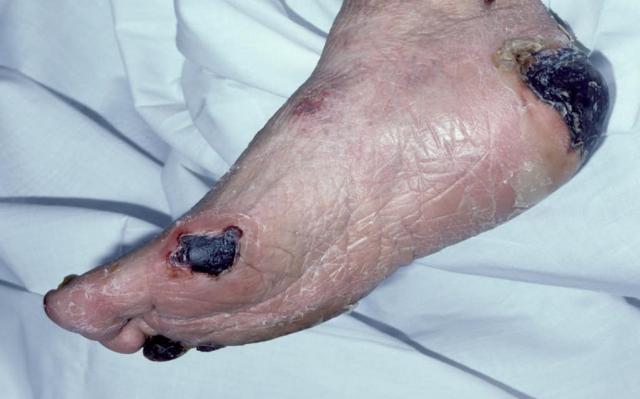Gangrene is a serious condition characterized by the death of body tissue due to a lack of Blood Flow or a bacterial infection. It can affect any part of the body but most commonly occurs in the extremities, such as the toes, fingers, and limbs. The onset of Gangrene can be sudden or gradual, posing significant health risks if not promptly addressed. This article aims to provide comprehensive insights into the symptoms, causes, and available treatments for gangrene, alongside preventive measures to reduce the risk of its occurrence. Understanding these aspects is crucial for early detection and effective management of this potentially life-threatening condition.
Symptoms
The symptoms of gangrene vary based on its type and severity. In certain instances, symptoms might be entirely absent. Nevertheless, there are several key indicators to be vigilant for:
- Discoloration of skin: The affected area may appear red or purple in color.
- Pain: As gangrene progresses, the tissue dies, causing intense pain.
- Swelling: The impacted region may swell, becoming sensitive when touched.
- Blisters or sores: These can occur on the skin, accompanied by a foul odor.
- Numbness: In some cases, gangrene can cause numbness or tingling in the affected area.
- Should you encounter any of these symptoms, it’s crucial to promptly seek medical attention. Delayed treatment can lead to further complications, including sepsis and even death.
Causes
Gangrene occurs when tissue dies due to a lack of Blood flow or an infection. Some common causes include:
- Poor circulation: Conditions that affect blood flow, such as diabetes, atherosclerosis, and Raynaud’s disease can increase the risk of gangrene.
- Trauma: Injuries that damage blood vessels or reduce blood supply to an area can result in gangrene.
- Infection: Bacterial infections, including gas gangrene, can lead to tissue death if left untreated.
- Surgery or medical procedures: Certain surgeries and medical procedures that disrupt blood flow can put individuals at risk of developing gangrene.
Types of Gangrene
The two main causes of gangrene are a lack of blood flow (ischemia) and bacterial infection. These can occur separately or together, causing different types of gangrene:
- Dry gangrene: This type occurs when there is a lack of blood flow to the affected area, typically due to damaged or blocked blood vessels. It is commonly seen in people with diabetes and those with peripheral artery disease.
- Wet gangrene: This type occurs when there is an infection present in the dead tissue. The bacteria release toxins that further damage the surrounding healthy tissue.
- Gas gangrene: This rare but severe form of gangrene occurs when certain bacteria, such as Clostridium perfringens, infect the tissue. It can rapidly proliferate, resulting in potentially fatal complications.
Treatment Options
Treatment for gangrene focuses on removing the dead tissue, treating any infection, and restoring blood flow to the affected area. The specific treatment plan depends on the type and severity of the gangrene. Key options include:
- Surgical removal (debridement) of dead tissue: This is often the first step to prevent the spread of gangrene.
- Antibiotics: These are used to treat any underlying infection, especially in cases of wet and gas gangrene.
- Revascularization procedures: In cases where blood flow is restricted, procedures such as bypass surgery or angioplasty may be necessary to restore blood flow.
- Hyperbaric oxygen therapy: This treatment involves breathing pure oxygen in a pressurized room or chamber, which can help heal the affected tissue.
- Amputation: In severe cases, it may be necessary to amputate the affected limb or digits to prevent the spread of gangrene.
It’s crucial for patients to follow their healthcare provider’s recommendations closely, including lifestyle changes and management of underlying conditions, to support treatment effectiveness and prevent recurrence.
Preventive Measures
While gangrene cannot always be prevented, there are steps you can take to reduce your risk:
- Practice good hygiene: Properly clean and care for any wounds or injuries to prevent bacterial infection.
- Manage underlying health conditions: If you have diabetes or peripheral artery disease, it is crucial to manage them properly to reduce the risk of gangrene.
- Quit smoking: Smoking can lead to poor circulation and increase the risk of developing gangrene.
- Seek prompt medical attention: Any signs or symptoms of gangrene should be addressed immediately to prevent further complications.
Conclusion
Gangrene is a critical condition demanding immediate medical intervention. Knowing the symptoms, causes, and available treatment options can help with early detection and management of this potentially life-threatening condition. Additionally, taking preventive measures can reduce your risk of developing gangrene. If you experience any signs or symptoms of gangrene, seek medical attention immediately for proper diagnosis and treatment. So, it is important to be aware of the symptoms and take necessary precautions to prevent this condition from occurring. Stay informed, stay safe!
The post Gangrene Symptoms, Causes, Treatment, and More appeared first on LifeBei.
This post first appeared on LifeBei: Your Source For Health, Lifestyle, Decor, And Beauty, please read the originial post: here

